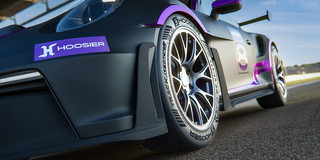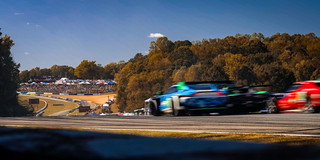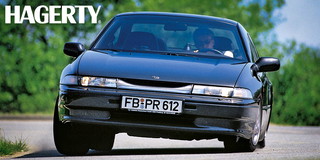
There are two truths to motorsports. One is that it’s fun. Like, super fun. The other is that you can never have enough brakes. Horsepower offers thrills, but regardless of whether you’re trying to drop time or just cruise around the course with a grin, motorsport events are significantly more enjoyable when you know your car will stop when you hit that middle peddle.
For those attending their first track event or autocross, realizing when a brake upgrade is needed can be tricky.
Luckily, the folks at Hawk Performance, the Official Brake Products of the SCCA®, have a few tricks that’ll keep the grin on your face all weekend long.
Hitting the Track
Racetracks can see you enjoying triple-digit speeds, repeatedly heavily braking into a variety of turns lap after lap. After a while, this can take a toll on brake components.
“Typically speaking, when you’re driving fast enough for the brake fluid to be over-stressed or over-heated, you’ll start to feel a softer brake pedal,” explains Mitch Bloom, Sales Manager for Hawk Performance. “It might take more pedal pressure or travel to achieve the deceleration that you want. This is because as the fluid heats up and builds temperature, it begins to boil, creating air bubbles. These air bubbles are compressible, which causes a longer stroke of the brake pedal, inconsistent pressure application, and an ever-worsening condition until everything cools off.”
A soft pedal due to overheated brake fluid is something many people will experience during track days (especially if they’re running stock brake fluid); it’s also something just about any driver will notice. But boiled fluid isn’t the only kind of brake-related fade people might experience. There’s also pad fade, which can be trickier to detect.
“When you go beyond the capabilities of the pads themselves – assuming fluid is OK – you’ll experience pad fade,” Bloom explains. “The sensations experienced are similar but have some key characteristics that will help you differentiate between fluid or pad fade.”
Pad fade will result in a brake pedal that feels fine, but the car itself isn’t slowing down as much as before, regardless of how hard the pedal is pushed. This, says Bloom, is “extreme” pad fade and will not happen all a sudden.
Your vehicle may be experiencing pad fade if the following exist:
- The initial bite has “softened”
- Increased pedal stroke might be required to build more friction
- Pedal pressure and the friction produced might become inconsistent
- Excessive brake pad wear
- Excessive brake pad taper (due to extreme pressures exerted to slow down, and the resulting caliper/hub flex)
Time to Upgrade? It Depends…
The ultimate question here is, should you upgrade your brake pads and fluid with something more stout before doing a track day?
“It really depends,” Bloom admits. “It’s going to primarily come down to the car, but also the driver’s previous skill. If the driver is 100% new to on-track driving and has never really driven fast before, I would have a different suggestion versus someone who dipped their toes in the autocross space but are looking for more speed.”
For example, for someone driving a Camaro SS 1LE at VIR or Road America, Bloom “absolutely suggests” at the very least a brake fluid upgrade (as the stock pads that come with that car should do the job fine). However, for a novice driving a 10th gen Civic Si at Mid-Ohio or Nelson Ledges, a 100% stock system should work.
As a driver’s speeds increase, though, that driver will get closer to the limits of the car’s brake pads and fluid, making upgrades a necessity.
What About Autocross?
Because of the nature of the sport, autocross doesn’t push a car’s brakes in quite the same way as hitting the track. Because of this, Bloom notes that fade (be it fluid or pad) isn’t as much of an issue.
“Typically, autocrossers won’t see fluid fade to an extreme and should never really see pad fade unless they’re using off-the-shelf auto parts store stuff,” he says. “What they might experience – especially with a codriver – is a very slightly soft pedal the first couple of braking zones, as the fluid in the caliper has heat soaked, but nothing shocking.”
None of that is to say that performance brake pads won’t increase a car’s braking potential and consistency in autocross, thus dropping run times.
Don’t Forget Maintenance
Regardless of whether you think your car needs it, Bloom always suggests upgrading brake fluid – but it’s more than that.
“Making sure that you have clean, fresh, high-quality fluid is paramount,” he says. “Look for color inconsistencies or discoloration to indicate heat cycling. Also, note when the fluid is changed so that you can track the maintenance.”
How long can you go between brake fluid flushes? Bloom suggests, at a minimum, annually.
“The entire brake system should be flushed at minimum once per year,” he says, adding that after-event maintenance is also a must. “The calipers should be bled until clean fluid appears after a weekend on track. Some cars might require more, some less, but this is a good starting point.”
If you think you’re ready to upgrade your brake fluid or pads, consider supporting an SCCA partner by visiting hawkperformance.com. From Hawk’s new autocross HPX pads to its ER-1 road racing pads, plus the company’s HP 520, HP600, and HP660 brake fluid, Hawk has you covered.
Photo by Michael Berchak










